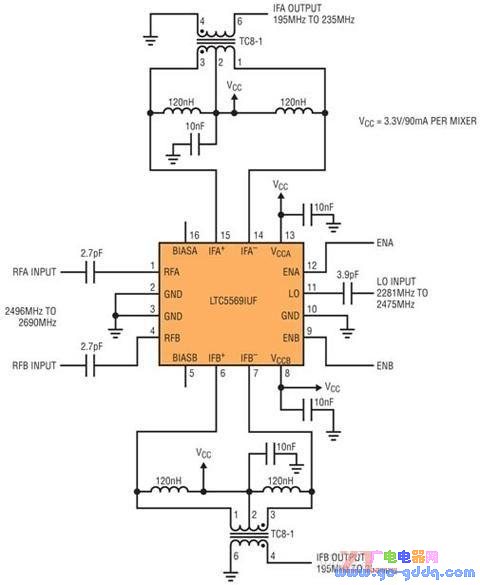High-performance wireless base stations are undergoing significant transformations to make the deployment of costly 4G networks more efficient and practical. As 4G data transfer rates increase dramatically compared to 3G, the performance demands on equipment have become more complex. Designers now face several key challenges:
- Integrating multiple MIMO (Multiple Input, Multiple Output) channels into the RF unit.
- Reducing the size of the RF unit to fit into a compact enclosure.
- Enabling flexible configuration of RF units to support various frequency bands and communication standards.
As a result, the next generation of base stations may look quite different from traditional models. Instead of large, air-conditioned rack-mounted systems, we’re seeing smaller, weatherproof enclosures—commonly known as RRH (Remote Radio Head) or RRU (Remote Radio Unit)—placed at the top of towers. These units are about the size of a desktop computer and are built to endure harsh environmental conditions. Each unit contains numerous RF electronic channels but lacks baseband processing capabilities. The modulated signals are transmitted via high-speed fiber optic cables or microwave links to a central base unit located kilometers away, which then distributes the signal to multiple cellular base stations. This architecture is scalable and cost-effective for deployment.
Another emerging trend in next-generation systems is the ability to operate across multiple frequency bands, often supporting multi-mode functionality. Such systems can be easily reconfigured through software to meet the specific requirements of any carrier, regardless of the frequency band or communication standard used.
MIMO receivers significantly enhance network capacity. For any new generation of base stations, the primary goal is to deliver higher data transfer rates to meet growing demand. With the rise of smartphones, laptops, and tablets, today’s networks are often overloaded. By operating two or more orthogonal receive channels in parallel, MIMO transceivers help achieve faster data rates. The data streams from these channels are combined to boost overall throughput.
In addition, multiple channels help reduce the impact of fading and multipath interference, which can cause performance issues and data loss. The LTC5569 dual-channel mixer from Linear Technology is designed for simultaneous reception with phase coherence between both channels. While this can also be achieved using two separate mixers, integrating both into a single chip ensures better consistency and matching. This design supports superior spatial diversity by enabling tight coupling with two physically separated antennas or patch elements, resulting in improved signal integrity.
Smart antennas can further enhance MIMO performance by intelligently directing signals in the same direction they are received. To do this, multiple receiving channels must measure the angle of incoming signals, making LO phase coherence essential between the channels.
Larger bandwidth enables multi-mode operation. 4G networks are expected to offer much higher data rates and wider bandwidths than 3G, allowing for more flexible and powerful communication. The wireless industry is pushing bandwidth requirements from 40MHz to 65MHz, and even up to 75MHz in some cases. This presents a significant challenge for RF engineers, as maintaining gain flatness across such wide ranges is technically demanding.
Figure 1 shows an application circuit using the LTC5569 dual-channel mixer as an uplink receiver operating in the LTE TDD band from 2496MHz to 2690MHz. The design is simple and uses minimal external components.

Figure 1: Example of a circuit operating on the MIMO TDD LTE band from 2496MHz to 2690MHz
In this application, the LTC5569's IF output covers the 195MHz to 235MHz range. It is optimized for excellent return loss at higher IF frequencies to improve frequency response flatness. Measured IF output return loss is 20dB at 235MHz and 14dB at 195MHz, achieving ±0.3dB flatness over a 40MHz IF bandwidth.
This website aims to provide advertising services for small and micro-enterprises. We recommend maintenance points and effective solutions that are affordable and practical. Feel free to contact us via QQ or email!
Why do you want to do online advertising?
|
- 0
- like
| Try to find the information you want. Inverter sensor patch three no weight loss camera LCD monitor does not boot digital camera XC9237 projector switching power supply laptop processor IPSUSB skills entrepreneurial black screen water heater can not boot circuit design silent transformer XC6102 without sound XC6112 display regulator no image microwave player successful silent GPS tea no picture XC6222 health XC6372 relay filter ML6209 switch washing machine digital camera description remote control without grating 555 protection circuit cancer self-closing Linux charger mobile phone shutdown noise inverter oscilloscope robot Windows antenna indicator light is not bright fiber life transformer stomach market alarm Hard disk watch embedded system woman maintenance process memory XC9236 converter router interview server kidney RFIDLED driver Konka CDMA instrument Panasonic CCD flashing engine multimeter Apple liver motor resistance keyboard integrated circuit current transformer triode governor power supply LED |
Recommended Articles | Favorite | Recommend | Print | Finishing: gddq | Read: Times 
Interactive Conference Board,Touchscreen Interactive Conference Board,Intelligent Interactive Conference Board,Business Interactive Meeting Board
Jiangsu Qilong Electronic Technology Co., Ltd. , https://www.qilongtouch.com